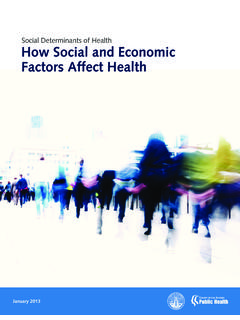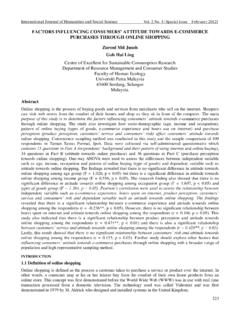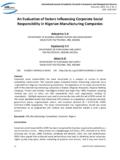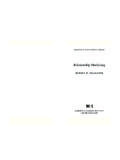Transcription of Labour market participation: the influence of …
1 Labour marketparticipation: theinfluence of socialcapitalBy Keith Brook, Labour market Division, Office for National StatisticsOffice for National Statistics Labour market Trends March 2005 IntroductionHuman capital, defined byskills and qualifications,and to a lesser extentpersonal capital, defined in terms ofbehavioural characteristics, areconsidered to be key determinants ingaining employment or progressingin the workplace. In recent years ithas been recognised that anadditional determinant defined associal capital can also have animportant influence . Both withinand outside the workplace, theextent to which individuals eithercontribute to or experienceneighbourliness, trust, socialnetworks or civic participation canhave an influence on a range ofimportant personal outcomesincluding health, education andemployment. The concept of socialcapital is used to describe thisinteraction between people and thewider the context of employment, social capital can be seen as apositive asset for those who areseeking to find work or change jobswithin the Labour market .
2 It can alsobe considered in terms of creatingopportunities for, or barriers to,career progression and/or jobretention. It needs to be recognised,however, that while the benefits ofsocial capital within the labourmarket can often be seen as apositive asset, they can also be seento disadvantage other groups orindividuals. As part of a broaderstudy into the influence of socialcapital in the UK, ONS has recentlycompleted a review of relevantstudies undertaken in the UK and anumber of other countries. Thisarticle discusses their findings inrelation to the UK Labour market inorder to raise awareness of thepotential influence of social capitalin the should be noted, however, that, inrelation to the Labour market , theinfluence of social capital within aparticular country is affected by thestructure and level of welfareprovision by the state and/or thevoluntary or private sector. Some ofthe studies discussed in this articleare from countries which have adifferent social framework to the featureLabour market participation : the influence of social capital Individual skills and experience,often referred to as humancapital, have traditionally beenconsidered to have a heavyinfluence on participation andprogress within the labourmarket.
3 In recent years socialcapital, defined in terms of thelevel of trust and cooperationexperienced between individualsor within groups, has also beenrecognised as having a role toplay. As part of a wider study of socialcapital in the UK, ONS hasundertaken a review of availabledata specific to the UK and ofstudies from other countriesrelating social capital to labourmarket participation . The results of such studies assistin understanding how socialcapital can influence the UKlabour market . This may be, forexample, by helping to increasethe participation of women anddisadvantaged groups, such asthe long-term sick and disabledand those from ethnic pointsSpecial featureFeature 3 March 2005 1/3/05 4:53 pm Page 113 social capital and thelabour marketONS has adopted a definition ofsocial capital given by Cote and Healy(2001) from the Organisation forEconomic Cooperation andDevelopment. They describe socialcapital as networks together withshared norms, values andunderstandings that facilitatecooperation within or among groups.
4 Three forms of social capital havebeen proposed, namely bonding,bridging and linking. Bonding refersto the interaction between similartypes of people such as familymembers and close personal includes looser ties withcasual friends, colleagues or associatesand, while weaker and more diversethan bonding relationships, is moreimportant in getting ahead . Linkingdescribes connections withorganisations and institutions andassists in accruing support frompeople in authority, for example,from the UK welfare state membership of social ,educational, political, religious andvoluntary organisations, both withinand outside the workplace, may alsocontribute to an individual s socialcapital. participation in such groupsmay help an individual to developskills or strengthen and extendnetworks which may assist inacquiring a 1shows how social capital,together with an individual s humanand personal capital, can influenceand assist those who areunemployed or inactive to find a jobor, if already employed, to changejobs or progress within theworkplace.
5 When looking for a job, social capital may be a positive assetin terms of networks which provideknowledge of availableopportunities. For the employer,Office for National Statistics Labour market Trends March 2005when existing employeesrecommend friends or acquaintancesthis can help to build trust inprospective candidates. This may beparticularly relevant for low skilledjobs where a large number ofapplicants are considered to haveequally suitable skills andexperience. Recruiting thoserecommended by existing employeesmakes use of social capital in termsof networks and trust since they areunlikely to recommend someonewhose performance coulddisadvantage their own positionwithin the featureLabour market participation : the influence of social capital114 DimensionSocial participationCivic participationSocial networks and social supportReciprocity and trustViews of the local areaFramework for measurement of social capitalBox1 Examples of indicators Number of cultural, leisure, socialgroups belonged to andfrequency and intensity ofinvolvement Volunteering.
6 Frequency andintensity of involvement Religious activity Perceptions of ability to influenceevents How well informed aboutlocal/national affairs Contact with public officials orpolitical representatives Involvement with local actiongroups Propensity to vote Frequency of seeing/speaking torelatives/friends/neighbours Extent of virtual networks andfrequency of contact Number of close friends/relativeswho live nearby Exchange of help Perceived control and satisfactionwith life Trust in other people who are likeyou Trust in other people who are notlike you Confidence in institutions atdifferent levels Doing favours and vice versa Perception of shared values Views on physical environment Facilities in the area Enjoyment of living in the area Fear of crimeFeature 3 March 2005 1/3/05 4:53 pm Page 114 Office for National Statistics Labour market Trends March 2005115 Special featureLabour market participation : the influence of social capitalInfluence of social capital in the Labour marketFigure 1 Source: Office for National StatisticsBondingFamily and friendsBridgingColleagues and associatesLinkingOrganisations and institutionsPersonal capitalBehavioural characteristicsJob separationVoluntary/involuntaryHuman capitalSkills, qualificationsSocial capitalContacts, trust,membership of groupsVoluntary activitiesEmployedUnemployed, inactiveJob searchProgression in workplaceFeature 3 March 2005 1/3/05 4:53 pm Page 115 social capital in the UKONS has recently undertaken a studyinto the development of aframework for the measurement andanalysis of social capital in the UK(summarised in Box 1, for further details).
7 This includesharmonised questions to measuresocial capital for use in national and local surveys. These haverecently been agreed by a cross-government working groupand are being incorporated into the UK General Household Surveyfor 2004 2001, the Home Office hasundertaken a biennial CitizenshipSurvey which is designed to be partof the evidence base for itscommunity policy area. Thisincludes modules on social capitaland full details are given survey isdesigned around the following fivemodules, although the contents mayvary for each survey. Good citizen: information onperception of rights andresponsibilities and whetherpeople feel they can influencedecisions and trust institutions. Neighbourhood: information onwhether people know, socialisewith and trust neighbours;collective efficacy; and socialcapital. Active communities: informationon civic participation andinformal and formal volunteeringincluding frequency, intensity,duration and barriers. Racial prejudice anddiscrimination: information onperceptions of racial prejudice inBritain and perceptions ofdiscrimination by public andprivate sector for National Statistics Labour market Trends March 2005 Family and parenting:information on family structures,family level social capital andparenting discussion of social capitalwithin the UK was included in arecent social Trends(seeHaezewindt, 2003).
8 Indicators ofsocial capital include the level ofturnout for general elections, whichhas declined since 1990. Another isthe level of community spirit, whichthe British Crime Survey reports haschanged little over the past ten yearsin terms of the number ofneighbourhoods who are perceivedto help each other . However, a socialcapital module included in theGeneral Household Survey in2000/01 reported the level of trust inneighbours increased consistently byage group from just below 40 percent for 16 to 29-year-olds to over 75per cent for those aged 70 and ble 1,which is based on ananalysis of General HouseholdSurvey data, shows a comparison ofthe typical characteristics of peoplewith high and low social capital. Thisindicates that those in employmenttend to have higher levels of socialcapital than those who areunemployed. However, this may be asimplification since the duration ofunemployment, or the socio-economic status of those who areinactive, and in some caseshousehold composition, will alsohave an Performance and InnovationUnit has undertaken a detailed reviewof social capital (Aldridge et al.)
9 , 2002)and its possible influence on differentaspects of UK society, which includesfacilitating higher levels of, andgrowth in, GDP through moreefficient Labour markets. High levelsof social capital can also beconsidered to facilitate educationalattainment, better health and lowerlevels of crime, which in turn canhave an impact on Labour marketoutcomes. The report concluded thatwhile the various aspects of socialcapital may have some impact on anumber of policy issues, it is likelythat a number of other factors willneed to be featureLabour market participation : the influence of social capital116 Illustrative characteristics of people with high and low social capitalTable 1 High social capitalLow social capitalLives outside London regionLives in London regionAged 30 and overAged 29 and underWomenMenMarriedSingleHighly educatedLittle or no educationHigher incomeLower incomeEmployedUnemployedLeast deprived areaMost deprived areaHomeownerPrivate renter5 and over years of residence0 to 4 years of residenceSource: General Household SurveyFeature 3 March 2005 1/3/05 4.
10 53 pm Page 116 social capital in the labourmarket and the widercommunityWhile social capital may assist thosewho are actively participating in thelabour market , this can have adetrimental effect on other sectors ofsociety who are more reliant on careand support from family or voluntaryorganisations. Over the past 20 years,the number of women inemployment has increased steadilywhile the number of men hasdecreased. However, recent studies byHall (1999) and Putnam (2000)indicate that communityparticipation in the US has declinedamong all women and men regardlessof their employment relationship between socialcapital, the Labour market andcommunity participation also hasrelevance in the context of a familyunit. For example, children or elderlyparents may be deprived of, or haveless access to, traditional familynetworks or support because of timedemands on their working parents orchildren. The relationship betweentime use and social capital in thiscontext is being investigated by SouthBank University, and the followingOffice for National Statistics Labour market Trends March 2005four overlapping areas have beenidentified (see Gray, 2003): employment-enhancingnetworks, influencing job access,job satisfaction, and negotiatingcapacity; informal sociality and support; associations and civil society; the care environment, includingcare of children; the sick anddisabled; the interaction of these four areasis an important issue when analysingsocial capital within the labourmarket.






